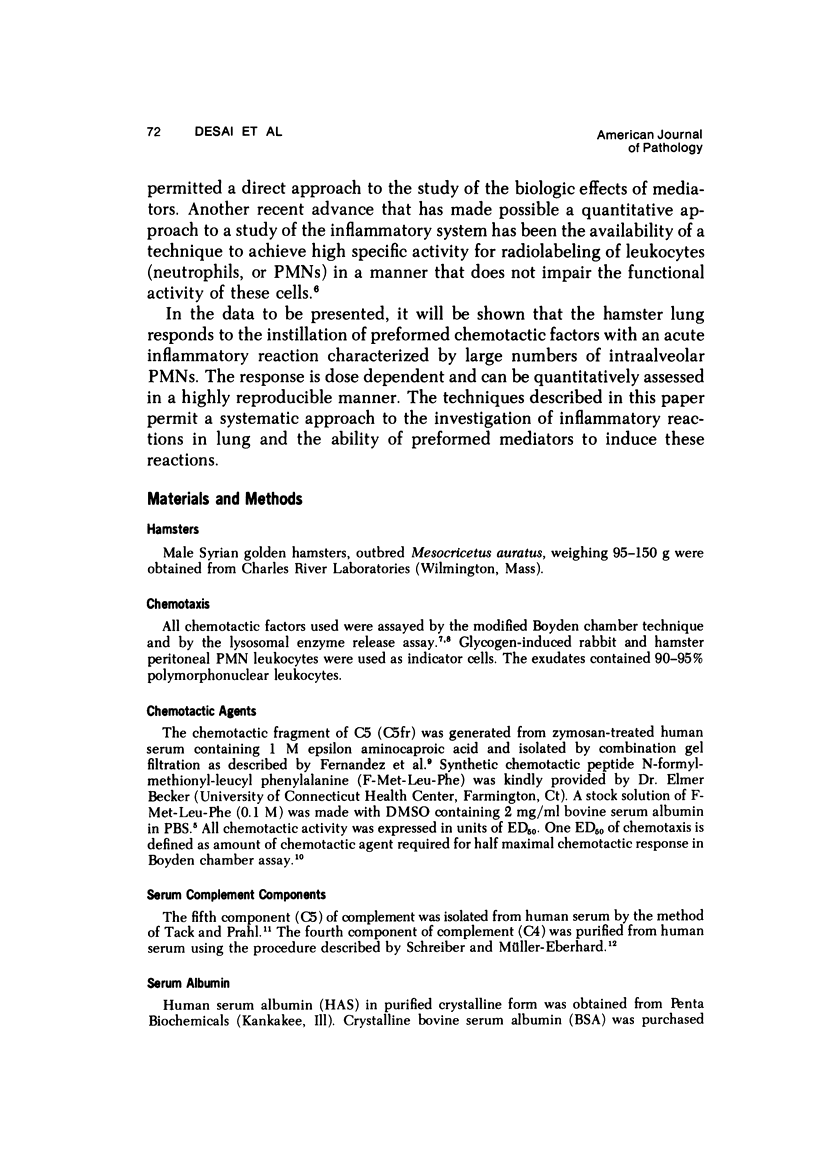Abstract
Acute inflammatory reactions have been produced in hamster lungs by the intrapulmonary instillation of preformed chemotactic mediators (C5fr and F-Met-Leu-Phe). By the use of 111Indium and 125Iodine labeling of homologous neutrophils (PMNs) and homologous albumin, respectively, it has been possible to obtain highly reproducible and quantitative parameters of the acute inflammatory response. The lung responds in a dose-dependent and time-dependent manner to the instillation of preformed chemotactic mediators. The quantitative parameters indicative of PMN influx were more prominent than changes in vascular permeability. The data obtained by the use of radiolabeled PMNs were confirmed by observation with light microscopy. Nonchemotactic substances such as human IgG, serum albumin, and C4 failed to induce inflammatory responses in lung. Interestingly, intact C5 instilled into lung was extremely phlogistic, apparently due to hydrolysis once within the lung. These studies provide an approach to reliable quantitative parameters of inflammatory reactions in the lung and emphasize the in vivo biologic effects of chemotactic mediators.
Full text
PDF












Images in this article
Selected References
These references are in PubMed. This may not be the complete list of references from this article.
- Barr R. D., Dougherty W., Perry S. A reappraisal of cellular labeling with radiochromium salts. J Lab Clin Med. 1976 Dec;88(6):1032–1040. [PubMed] [Google Scholar]
- Boyum A. Separation of blood leucocytes, granulocytes and lymphocytes. Tissue Antigens. 1974;4(4):269–274. [PubMed] [Google Scholar]
- Brozna J. P., Senior R. M., Kreutzer D. L., Ward P. A. Chemotactic factor inactivators of human granulocytes. J Clin Invest. 1977 Dec;60(6):1280–1288. doi: 10.1172/JCI108887. [DOI] [PMC free article] [PubMed] [Google Scholar]
- Colten H. R. Biosynthesis of complement. Adv Immunol. 1976;22:67–118. doi: 10.1016/s0065-2776(08)60548-9. [DOI] [PubMed] [Google Scholar]
- Fernandez H. N., Henson P. M., Otani A., Hugli T. E. Chemotactic response to human C3a and C5a anaphylatoxins. I. Evaluation of C3a and C5a leukotaxis in vitro and under stimulated in vivo conditions. J Immunol. 1978 Jan;120(1):109–115. [PubMed] [Google Scholar]
- Grant J. A., Settle L., Whorton E. B., Dupree E. Complement-mediated release of histamine from human basophils. II. Biochemical characterization of the reaction. J Immunol. 1976 Aug;117(2):450–456. [PubMed] [Google Scholar]
- Johnson K. J., Anderson T. P., Ward P. A. Suppression of immune complex-induced inflammation by the chemotactic factor inactivator. J Clin Invest. 1977 May;59(5):951–958. doi: 10.1172/JCI108717. [DOI] [PMC free article] [PubMed] [Google Scholar]
- Johnson K. J., Ward P. A. Acute immunologic pulmonary alveolitis. J Clin Invest. 1974 Aug;54(2):349–357. doi: 10.1172/JCI107770. [DOI] [PMC free article] [PubMed] [Google Scholar]
- Jones D. G., Richardson D. L., Kay A. B. Neutrophil accumulation in vivo following the administration of chemotactic factors. Br J Haematol. 1977 Jan;35(1):19–24. doi: 10.1111/j.1365-2141.1977.tb00558.x. [DOI] [PubMed] [Google Scholar]
- Kreutzer D. L., O'Flaherty J. T., Orr W., Showell H. J., Ward P. A., Becker E. L. Quantitative comparisons of various biological responses of neutrophils to different active and inactive chemotactic factors. Immunopharmacology. 1978 Dec;1(1):39–47. doi: 10.1016/0162-3109(78)90007-3. [DOI] [PubMed] [Google Scholar]
- Krohn K., Sherman L., Welch M. Studies of radioiodinated fibrinogen. I. Physicochemical properties of the ICl, chloramine-T, and electrolytic reaction products. Biochim Biophys Acta. 1972 Dec 28;285(2):404–413. doi: 10.1016/0005-2795(72)90327-3. [DOI] [PubMed] [Google Scholar]
- Scherzer H., Ward P. A. Lung and dermal vascular injury produced by preformed immune complexes. Am Rev Respir Dis. 1978 Mar;117(3):551–557. doi: 10.1164/arrd.1978.117.3.551. [DOI] [PubMed] [Google Scholar]
- Schiffmann E., Corcoran B. A., Wahl S. M. N-formylmethionyl peptides as chemoattractants for leucocytes. Proc Natl Acad Sci U S A. 1975 Mar;72(3):1059–1062. doi: 10.1073/pnas.72.3.1059. [DOI] [PMC free article] [PubMed] [Google Scholar]
- Schreiber R. D., Müller-Eberhard H. J. Fourth component of human complement: description of a three polypeptide chain structure. J Exp Med. 1974 Nov 1;140(5):1324–1335. doi: 10.1084/jem.140.5.1324. [DOI] [PMC free article] [PubMed] [Google Scholar]
- Senior R. M., Tegner H., Kuhn C., Ohlsson K., Starcher B. C., Pierce J. A. The induction of pulmonary emphysema with human leukocyte elastase. Am Rev Respir Dis. 1977 Sep;116(3):469–475. doi: 10.1164/arrd.1977.116.3.469. [DOI] [PubMed] [Google Scholar]
- Showell H. J., Freer R. J., Zigmond S. H., Schiffmann E., Aswanikumar S., Corcoran B., Becker E. L. The structure-activity relations of synthetic peptides as chemotactic factors and inducers of lysosomal secretion for neutrophils. J Exp Med. 1976 May 1;143(5):1154–1169. doi: 10.1084/jem.143.5.1154. [DOI] [PMC free article] [PubMed] [Google Scholar]
- Tack B. D., Prahl J. W. Third component of human complement: purification from plasma and physicochemical characterization. Biochemistry. 1976 Oct 5;15(20):4513–4521. doi: 10.1021/bi00665a028. [DOI] [PubMed] [Google Scholar]
- Teplitz C. The core pathobiology and integrated medical science of adult acute respiratory insufficiency. Surg Clin North Am. 1976 Oct;56(5):1091–1133. doi: 10.1016/s0039-6109(16)41033-9. [DOI] [PubMed] [Google Scholar]
- Thakur M. L., Coleman R. E., Welch M. J. Indium-111-labeled leukocytes for the localization of abscesses: preparation, analysis, tissue distribution, and comparison with gallium-67 citrate in dogs. J Lab Clin Med. 1977 Jan;89(1):217–228. [PubMed] [Google Scholar]
- WARD P. A., COCHRANE C. G. BOUND COMPLEMENT AND IMMUNOLOGIC INJURY OF BLOOD VESSELS. J Exp Med. 1965 Feb 1;121:215–234. doi: 10.1084/jem.121.2.215. [DOI] [PMC free article] [PubMed] [Google Scholar]
- WARD P. A., COCHRANE C. G., MUELLER-EBERHARD H. J. THE ROLE OF SERUM COMPLEMENT IN CHEMOTAXIS OF LEUKOCYTES IN VITRO. J Exp Med. 1965 Aug 1;122:327–346. doi: 10.1084/jem.122.2.327. [DOI] [PMC free article] [PubMed] [Google Scholar]
- WARNER H. R., ATHENS J. W. AN ANALYSIS OF GRANULOCYTE KINETICS IN BLOOD AND BONE MARROW. Ann N Y Acad Sci. 1964 Feb 28;113:523–536. doi: 10.1111/j.1749-6632.1964.tb40689.x. [DOI] [PubMed] [Google Scholar]
- Ward P. A., Hill J. H. Biologic role of complement products. Complement-derived leukotactic activity extractable from lesions of immunologic vasculitis. J Immunol. 1972 May;108(5):1137–1145. [PubMed] [Google Scholar]
- Ward P. A., Hill J. H. Detection of lipopolysaccharide (LPS): an improved method for isolation of the Limulus extract. Proc Soc Exp Biol Med. 1972 Dec;141(3):898–900. doi: 10.3181/00379727-141-36897. [DOI] [PubMed] [Google Scholar]



